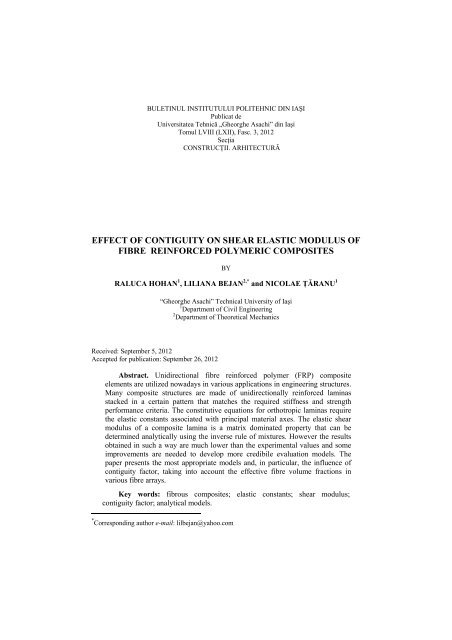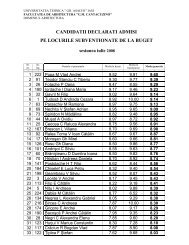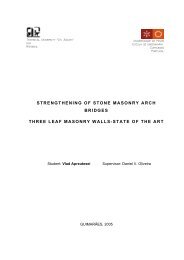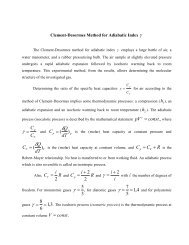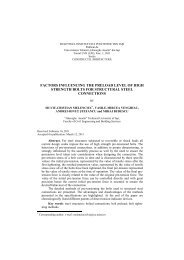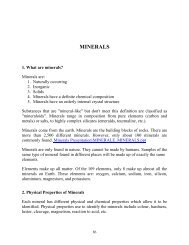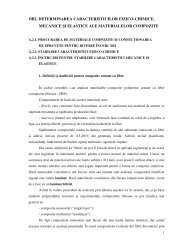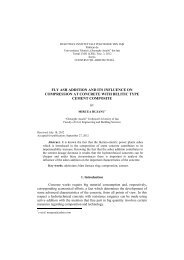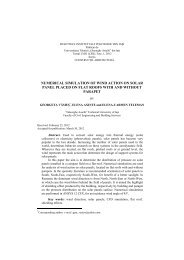effect of contiguity on shear elastic modulus of fibre reinforced ...
effect of contiguity on shear elastic modulus of fibre reinforced ...
effect of contiguity on shear elastic modulus of fibre reinforced ...
You also want an ePaper? Increase the reach of your titles
YUMPU automatically turns print PDFs into web optimized ePapers that Google loves.
BULETINUL INSTITUTULUI POLITEHNIC DIN IAŞI<br />
Publicat de<br />
Universitatea Tehnică „Gheorghe Asachi” din Iaşi<br />
Tomul LVIII (LXII), Fasc. 3, 2012<br />
Secţia<br />
CONSTRUCŢII. ARHITECTURĂ<br />
EFFECT OF CONTIGUITY ON SHEAR ELASTIC MODULUS OF<br />
FIBRE REINFORCED POLYMERIC COMPOSITES<br />
BY<br />
RALUCA HOHAN 1 , LILIANA BEJAN 2,* and NICOLAE ŢĂRANU 1<br />
Received: September 5, 2012<br />
Accepted for publicati<strong>on</strong>: September 26, 2012<br />
“Gheorghe Asachi” Technical University <str<strong>on</strong>g>of</str<strong>on</strong>g> Iaşi<br />
1 Department <str<strong>on</strong>g>of</str<strong>on</strong>g> Civil Engineering<br />
2 Department <str<strong>on</strong>g>of</str<strong>on</strong>g> Theoretical Mechanics<br />
Abstract. Unidirecti<strong>on</strong>al <strong>fibre</strong> <strong>reinforced</strong> polymer (FRP) composite<br />
elements are utilized nowadays in various applicati<strong>on</strong>s in engineering structures.<br />
Many composite structures are made <str<strong>on</strong>g>of</str<strong>on</strong>g> unidirecti<strong>on</strong>ally <strong>reinforced</strong> laminas<br />
stacked in a certain pattern that matches the required stiffness and strength<br />
performance criteria. The c<strong>on</strong>stitutive equati<strong>on</strong>s for orthotropic laminas require<br />
the <strong>elastic</strong> c<strong>on</strong>stants associated with principal material axes. The <strong>elastic</strong> <strong>shear</strong><br />
<strong>modulus</strong> <str<strong>on</strong>g>of</str<strong>on</strong>g> a composite lamina is a matrix dominated property that can be<br />
determined analytically using the inverse rule <str<strong>on</strong>g>of</str<strong>on</strong>g> mixtures. However the results<br />
obtained in such a way are much lower than the experimental values and some<br />
improvements are needed to develop more credibile evaluati<strong>on</strong> models. The<br />
paper presents the most appropriate models and, in particular, the influence <str<strong>on</strong>g>of</str<strong>on</strong>g><br />
<str<strong>on</strong>g>c<strong>on</strong>tiguity</str<strong>on</strong>g> factor, taking into account the <str<strong>on</strong>g>effect</str<strong>on</strong>g>ive <strong>fibre</strong> volume fracti<strong>on</strong>s in<br />
various <strong>fibre</strong> arrays.<br />
Key words: fibrous composites; <strong>elastic</strong> c<strong>on</strong>stants; <strong>shear</strong> <strong>modulus</strong>;<br />
<str<strong>on</strong>g>c<strong>on</strong>tiguity</str<strong>on</strong>g> factor; analytical models.<br />
* Corresp<strong>on</strong>ding author e-mail: lilbejan@yahoo.com
10 Raluca Hohan, Liliana Bejan and Nicolae Ţăranu<br />
1. Introducti<strong>on</strong><br />
Fibre <strong>reinforced</strong> polymer (FRP) composites c<strong>on</strong>sist <str<strong>on</strong>g>of</str<strong>on</strong>g> <strong>fibre</strong>s <str<strong>on</strong>g>of</str<strong>on</strong>g> high<br />
hardness, strength and <strong>modulus</strong> embedded in a s<str<strong>on</strong>g>of</str<strong>on</strong>g>ter and weaker matrix, with<br />
distinct interfaces between them. Both c<strong>on</strong>stituents retain their physical and<br />
chemical identities, but their combinati<strong>on</strong> leads to properties that cannot be<br />
achieved with either <str<strong>on</strong>g>of</str<strong>on</strong>g> comp<strong>on</strong>ents working individually (Mallick, 2008).<br />
In the case <str<strong>on</strong>g>of</str<strong>on</strong>g> FRP composites the reinforcing <strong>fibre</strong>s c<strong>on</strong>stitute the<br />
backb<strong>on</strong>e <str<strong>on</strong>g>of</str<strong>on</strong>g> the material and they determine most <str<strong>on</strong>g>of</str<strong>on</strong>g> its strength and stiffness in<br />
the directi<strong>on</strong> parallel to <strong>fibre</strong>s. The polymeric matrix binds together the <strong>fibre</strong>s<br />
and protects their surfaces from damage. It disperses the <strong>fibre</strong>s, separates them<br />
and also transfers stresses to them.<br />
Most composite structures made <str<strong>on</strong>g>of</str<strong>on</strong>g> fibrous composites c<strong>on</strong>sist <str<strong>on</strong>g>of</str<strong>on</strong>g><br />
several distinct unidirecti<strong>on</strong>al laminas.<br />
A unidirecti<strong>on</strong>al composite c<strong>on</strong>sists <str<strong>on</strong>g>of</str<strong>on</strong>g> parallel <strong>fibre</strong>s embedded in a<br />
matrix and a lamina is a flat or curved arrangement <str<strong>on</strong>g>of</str<strong>on</strong>g> unidirecti<strong>on</strong>al or woven<br />
<strong>fibre</strong>s in a support matrix.<br />
The unidirecti<strong>on</strong>al lamina (Fig. 1) is the basic building block in a<br />
laminated FRP composite. The directi<strong>on</strong> parallel to the <strong>fibre</strong>s is called the<br />
l<strong>on</strong>gitudinal directi<strong>on</strong> (axis 1 or L) and the directi<strong>on</strong> perpendicular to the <strong>fibre</strong>s<br />
in the 1-2 plane is called the transverse directi<strong>on</strong>. Any directi<strong>on</strong> in the 2-3 plane<br />
is also a transverse directi<strong>on</strong>. These axes are also referred to as the material<br />
axes <str<strong>on</strong>g>of</str<strong>on</strong>g> the lamina.<br />
Fig. 1 – A unidirecti<strong>on</strong>al <strong>fibre</strong> <strong>reinforced</strong> lamina<br />
with its principal material axes.<br />
The unidirecti<strong>on</strong>al composite shows different properties in the material<br />
axes directi<strong>on</strong>s. Thus, this type <str<strong>on</strong>g>of</str<strong>on</strong>g> composites is orthotropic with their axes 1, 2,<br />
3 as axes <str<strong>on</strong>g>of</str<strong>on</strong>g> symmetry.
Bul. Inst. Polit. Iaşi, t. LVIII (LXII), f. 3, 2012 11<br />
2. Plane Stresses State and Specially Orthotropic Lamina<br />
A lamina with the reference axes coinciding with the axes <str<strong>on</strong>g>of</str<strong>on</strong>g> material<br />
(Fig. 2) is called specially orthotropic lamina; the plane state <str<strong>on</strong>g>of</str<strong>on</strong>g> stresses, typical<br />
to this element, is also illustrated in this figure.<br />
Fig. 2 – Specially orthotropic lamina under plane state <str<strong>on</strong>g>of</str<strong>on</strong>g> stress.<br />
In the analysis <str<strong>on</strong>g>of</str<strong>on</strong>g> composite structures it is <str<strong>on</strong>g>of</str<strong>on</strong>g>ten the case when a<br />
c<strong>on</strong>diti<strong>on</strong> <str<strong>on</strong>g>of</str<strong>on</strong>g> plane stress actually exists or it is a very good approximati<strong>on</strong>.<br />
C<strong>on</strong>stitutive eqs. in principal material coordinates <str<strong>on</strong>g>of</str<strong>on</strong>g> a specially orthotropic<br />
lamina for the plane stress state (Tsai et al., 1980; Mallick, 2008) are<br />
⎧σ ⎫ ⎡Q Q 0 ⎤⎧ε ⎫<br />
1 11 12 1<br />
⎪ ⎪<br />
σ<br />
⎢<br />
2 Q12 Q22<br />
0<br />
⎥⎪<br />
⎪<br />
⎨ ⎬= ⎢ ⎥⎨ε2<br />
⎬,<br />
⎪τ ⎪<br />
12 0 0 Q ⎪<br />
66 γ ⎪<br />
⎩ ⎭ ⎣⎢ ⎦⎩ ⎥ 12 ⎭<br />
where Qij , (i, j = 1, 2, 3), are the terms <str<strong>on</strong>g>of</str<strong>on</strong>g> the reduced stiffness matrix.<br />
It may be pointed out that for two-dimensi<strong>on</strong>al orthotropy <strong>on</strong>ly four<br />
c<strong>on</strong>stants are needed namely, E1, E2, G12 and ν12; these c<strong>on</strong>stants can be<br />
measured in the laboratory and are termed engineering c<strong>on</strong>stants.<br />
The expressi<strong>on</strong>s for Qij, in terms <str<strong>on</strong>g>of</str<strong>on</strong>g> engineering c<strong>on</strong>stants, are<br />
E<br />
1 Q 11 = ,<br />
1−ν 21ν<br />
12<br />
Q<br />
E<br />
12<br />
ν 21E1ν12E2 = =<br />
1−νν 1−ν<br />
ν<br />
21 12 21 12<br />
2 Q 22 = , 66 12<br />
1−ν 21ν<br />
12<br />
, Q G =<br />
where E1 is the l<strong>on</strong>gitudinal <strong>elastic</strong> <strong>modulus</strong>, al<strong>on</strong>g the <strong>fibre</strong>s (1), E2 – the<br />
transverse <strong>elastic</strong> <strong>modulus</strong>, perpendicular to the <strong>fibre</strong>s directi<strong>on</strong> (2), G12 – the<br />
,<br />
(1)<br />
(2)
12 Raluca Hohan, Liliana Bejan and Nicolae Ţăranu<br />
<strong>shear</strong> <strong>modulus</strong> <str<strong>on</strong>g>of</str<strong>on</strong>g> <strong>elastic</strong>ity in the plane <str<strong>on</strong>g>of</str<strong>on</strong>g> lamina (1, 2), ν12 – the major<br />
Poiss<strong>on</strong>’s ratio and ν21 – the minor Poiss<strong>on</strong>’s ratio.<br />
The stiffness properties can be determined by experimental<br />
measurements, but <strong>on</strong>e set <str<strong>on</strong>g>of</str<strong>on</strong>g> experimental measurements determines the<br />
properties <str<strong>on</strong>g>of</str<strong>on</strong>g> a <strong>fibre</strong>-matrix system produced by a single fabricati<strong>on</strong> process.<br />
When any change in the system variables occur, additi<strong>on</strong>al measurements are<br />
required. These experiments may become time c<strong>on</strong>suming and cost prohibitive;<br />
therefore, a variety <str<strong>on</strong>g>of</str<strong>on</strong>g> methods, based <strong>on</strong> micromechanics, have been used to<br />
predict them (Agarwal et al., 2006; Daniel et al., 2006). In predicti<strong>on</strong> studies,<br />
micromechanics mean the analysis <str<strong>on</strong>g>of</str<strong>on</strong>g> the <str<strong>on</strong>g>effect</str<strong>on</strong>g>ive composite properties in<br />
terms <str<strong>on</strong>g>of</str<strong>on</strong>g> c<strong>on</strong>stituent material properties. The E-glass <strong>fibre</strong>s have been utilized in<br />
the analysis presented in this paper. Many FRP composites for structural<br />
applicati<strong>on</strong>s in civil engineering are based <strong>on</strong> thermosetting polymers. These<br />
polymers develop a spatial network that sets them in shape. If they are heated<br />
after they have been cured, they do not melt and will retain their shape until<br />
they begin to thermally decompose at high temperature (Askeland et al., 2010;<br />
Hollaway, 2010). An epoxy polymer matrix with <strong>elastic</strong> <strong>modulus</strong> E = 3 GPa and<br />
Poiss<strong>on</strong>’s ratio ν = 0.38 has been utilized in this paper for numerical<br />
calculati<strong>on</strong>s.<br />
3. Geometry <str<strong>on</strong>g>of</str<strong>on</strong>g> Fibres Distributi<strong>on</strong> and C<strong>on</strong>tiguity<br />
The range <str<strong>on</strong>g>of</str<strong>on</strong>g> c<strong>on</strong>stituent volume fracti<strong>on</strong>s that may be expected in <strong>fibre</strong><br />
<strong>reinforced</strong> composites can be determined using representative area elements for<br />
idealized <strong>fibre</strong>-packing geometries such as the triangular and square arrays<br />
shown in Fig. 3.<br />
a b<br />
Fig. 3 – Representative area elements for idealized <strong>fibre</strong>- packing geometries<br />
a – square array and <strong>fibre</strong>s positi<strong>on</strong> for Vf max; b – triangular array and <strong>fibre</strong>s<br />
positi<strong>on</strong> for Vf max.<br />
If it is assumed that the <strong>fibre</strong> spacing, s, and the <strong>fibre</strong> diameter, d, do not<br />
change al<strong>on</strong>g the <strong>fibre</strong> length, then, the area fracti<strong>on</strong>s must be equal to the<br />
volume fracti<strong>on</strong>s (Ţăranu et al., 2005) The <strong>fibre</strong> volume fracti<strong>on</strong> for the square<br />
array is found by dividing the area <str<strong>on</strong>g>of</str<strong>on</strong>g> the <strong>fibre</strong> enclosed in the square by the<br />
total area <str<strong>on</strong>g>of</str<strong>on</strong>g> square. The maximum theoretical <strong>fibre</strong> volume fracti<strong>on</strong> in the<br />
square area occurs when s = d,
Bul. Inst. Polit. Iaşi, t. LVIII (LXII), f. 3, 2012 13<br />
V f<br />
π<br />
4<br />
max = = 0.785.<br />
In case <str<strong>on</strong>g>of</str<strong>on</strong>g> a triangular array when s = d, the maximum <strong>fibre</strong> volume<br />
fracti<strong>on</strong> is<br />
V f<br />
π<br />
max = = 0.907.<br />
2 3<br />
These theoretical limits are not generally achievable in practice. In most<br />
c<strong>on</strong>tinuous <strong>fibre</strong> composites the <strong>fibre</strong> volume fracti<strong>on</strong>s range from 0.5 to 0.75.<br />
The reinforcing <strong>fibre</strong>s <strong>on</strong> the cross secti<strong>on</strong> <str<strong>on</strong>g>of</str<strong>on</strong>g> unidirecti<strong>on</strong>al composite<br />
materials are usually randomly arranged (Fig. 4 b) instead <str<strong>on</strong>g>of</str<strong>on</strong>g> being distributed<br />
in a regular array.<br />
a b c<br />
Fig. 4 – Various schemes <str<strong>on</strong>g>of</str<strong>on</strong>g> <strong>fibre</strong> <str<strong>on</strong>g>c<strong>on</strong>tiguity</str<strong>on</strong>g>: a – isolated <strong>fibre</strong>s (C = 0); b – actual<br />
random <strong>fibre</strong> (0 < C < 1); c – isolated matrix (C = 1).<br />
C<strong>on</strong>sidering C as the degree <str<strong>on</strong>g>of</str<strong>on</strong>g> <str<strong>on</strong>g>c<strong>on</strong>tiguity</str<strong>on</strong>g>, C = 0 corresp<strong>on</strong>ds to isolated<br />
<strong>fibre</strong>s (Fig. 4 a) and C = 1 corresp<strong>on</strong>ds to all c<strong>on</strong>tiguous <strong>fibre</strong>s (Fig. 4 c).<br />
4. The Influence <str<strong>on</strong>g>of</str<strong>on</strong>g> C<strong>on</strong>tiguity <strong>on</strong> the Shear Elastic Modulus<br />
The behaviour <str<strong>on</strong>g>of</str<strong>on</strong>g> unidirecti<strong>on</strong>al composites under in-plane <strong>shear</strong><br />
loading is dominated by the matrix properties and the local stress distributi<strong>on</strong>s.<br />
The mechanics <str<strong>on</strong>g>of</str<strong>on</strong>g> materials approach uses a series model under uniform <strong>shear</strong><br />
stress (Fig. 5) to determine the <strong>shear</strong> <strong>modulus</strong>.<br />
Fig. 5 – The model used for the <strong>shear</strong> <strong>elastic</strong><br />
<strong>modulus</strong> analytical evaluati<strong>on</strong>.<br />
(3)<br />
(4)
14 Raluca Hohan, Liliana Bejan and Nicolae Ţăranu<br />
The <strong>shear</strong> stresses are equal in <strong>fibre</strong>s, matrix and composite and the<br />
compatibility <str<strong>on</strong>g>of</str<strong>on</strong>g> <strong>shear</strong> deformati<strong>on</strong>s is assured (Gibs<strong>on</strong>, 2012). The in-plane<br />
<strong>shear</strong> <strong>modulus</strong>, G12, determined <strong>on</strong> the model is defined by relati<strong>on</strong><br />
G<br />
12<br />
τ<br />
=<br />
γ<br />
where τ12 is average composite <strong>shear</strong> stress in the (1,2) plane and γ12 is the<br />
average engineering <strong>shear</strong> strain in the same plane.<br />
Using the model given in Fig. 5, a formula based <strong>on</strong> the inverse rule <str<strong>on</strong>g>of</str<strong>on</strong>g><br />
mixtures has been deduced<br />
G<br />
12<br />
12<br />
GG<br />
f m<br />
12 =<br />
,<br />
GV m f + GV f m<br />
Fig. 6 – Variati<strong>on</strong> <str<strong>on</strong>g>of</str<strong>on</strong>g> G12 by inverse rule <str<strong>on</strong>g>of</str<strong>on</strong>g> mixtures compared to extreme <str<strong>on</strong>g>c<strong>on</strong>tiguity</str<strong>on</strong>g>.<br />
and the corresp<strong>on</strong>ding <strong>shear</strong> <strong>modulus</strong> values are illustrated in Fig. 6, the bottom<br />
curve, where G12 is the in-plane <strong>shear</strong> <strong>modulus</strong> <str<strong>on</strong>g>of</str<strong>on</strong>g> the composite, Gf – the <strong>shear</strong><br />
<strong>modulus</strong> <str<strong>on</strong>g>of</str<strong>on</strong>g> <strong>fibre</strong>s, Gm – the <strong>shear</strong> <strong>modulus</strong> <str<strong>on</strong>g>of</str<strong>on</strong>g> matrix; Vf and Vm – the <strong>fibre</strong>s and<br />
matrix volume fracti<strong>on</strong>s, respectively.<br />
,<br />
(5)<br />
(6)
Bul. Inst. Polit. Iaşi, t. LVIII (LXII), f. 3, 2012 15<br />
The utilized model for G12 does not give precise results because it is<br />
based <strong>on</strong> many simplificati<strong>on</strong>s. In additi<strong>on</strong>, the <strong>shear</strong> <strong>modulus</strong> values<br />
determined experimentally are significantly higher than those determined with<br />
eq. (6). To obtain more accurate results complex analyses have been performed<br />
to give c<strong>on</strong>venient predicti<strong>on</strong>s (Mathews et al., 2008). Some attempts have<br />
focussed <strong>on</strong> improving the inverse rule <str<strong>on</strong>g>of</str<strong>on</strong>g> mixture formula for <strong>shear</strong> loading,<br />
<strong>on</strong>e <str<strong>on</strong>g>of</str<strong>on</strong>g> them based <strong>on</strong> <str<strong>on</strong>g>c<strong>on</strong>tiguity</str<strong>on</strong>g>.<br />
The approach that c<strong>on</strong>siders the <str<strong>on</strong>g>c<strong>on</strong>tiguity</str<strong>on</strong>g> has been analysed by Tsai<br />
(J<strong>on</strong>es, 1999) who has developed the following formulas for the <strong>shear</strong> <strong>modulus</strong>:<br />
( )<br />
( )<br />
( ) ( )<br />
( ) ( )<br />
2Gf−<br />
Gf − Gm Vm Gf + Gm − Gf −Gm<br />
Vm<br />
G12 = ( 1−<br />
C) Gm + CG f<br />
.<br />
2G<br />
+ G − G V G + G + G − G V<br />
m f m m f m f m m<br />
The <str<strong>on</strong>g>c<strong>on</strong>tiguity</str<strong>on</strong>g> factor, C, takes values between 0 and 1 (0 in case <str<strong>on</strong>g>of</str<strong>on</strong>g><br />
totally separated <strong>fibre</strong>s (Fig. 4 a) and 1 for total <strong>fibre</strong>s <str<strong>on</strong>g>c<strong>on</strong>tiguity</str<strong>on</strong>g> (Fig. 4 c)). An<br />
averaging factor has been used by the authors to determine the intermediate<br />
stiffness values, c<strong>on</strong>sidering the square array <str<strong>on</strong>g>of</str<strong>on</strong>g> reinforcing <strong>fibre</strong>s (C0.785) and<br />
the triangular array (C0.907) respectively. These averaging factors take into<br />
account the <str<strong>on</strong>g>effect</str<strong>on</strong>g>ive <strong>fibre</strong> volume fracti<strong>on</strong>s<br />
C<br />
V<br />
0785 .<br />
f<br />
0. 785 = ,<br />
C<br />
0907 .<br />
V f<br />
= .<br />
0. 907<br />
Figs. 7 a and 7b represent the influence <str<strong>on</strong>g>of</str<strong>on</strong>g> <str<strong>on</strong>g>c<strong>on</strong>tiguity</str<strong>on</strong>g> <strong>on</strong> <strong>shear</strong> <strong>modulus</strong>,<br />
c<strong>on</strong>sidering the averaging factor <str<strong>on</strong>g>effect</str<strong>on</strong>g>s (C0.785 and C0.907) versus extreme values<br />
<str<strong>on</strong>g>of</str<strong>on</strong>g> <str<strong>on</strong>g>c<strong>on</strong>tiguity</str<strong>on</strong>g> (C = 0 and C = 1).<br />
The specialized literature (Cooke, 1995) provides the upper (superior<br />
limit) and lower (inferior limit) bounds <str<strong>on</strong>g>of</str<strong>on</strong>g> <strong>shear</strong> <strong>modulus</strong>; the numerical results,<br />
calculated with these formulas, coincide with those obtained from formula (7) in<br />
which the extreme <str<strong>on</strong>g>c<strong>on</strong>tiguity</str<strong>on</strong>g> values have been introduced (Fig. 8)<br />
V f<br />
G12 − = Gm+<br />
1 Vm<br />
+<br />
G − G 2G<br />
f m m<br />
,<br />
Vm<br />
G12 + Gf<br />
1 V f<br />
G G 2G<br />
= +<br />
+<br />
−<br />
m f f<br />
.<br />
(7)<br />
(8)<br />
(9)
16 Raluca Hohan, Liliana Bejan and Nicolae Ţăranu<br />
a<br />
b<br />
Fig. 7 – Variati<strong>on</strong> <str<strong>on</strong>g>of</str<strong>on</strong>g> <strong>shear</strong> <strong>modulus</strong> including the influence <str<strong>on</strong>g>of</str<strong>on</strong>g> <strong>fibre</strong>s <str<strong>on</strong>g>c<strong>on</strong>tiguity</str<strong>on</strong>g>:<br />
a – averaging factor C0.785; b – averaging factor C0.907
Bul. Inst. Polit. Iaşi, t. LVIII (LXII), f. 3, 2012 17<br />
Fig. 8 – Superior and inferior limits for <strong>shear</strong> <strong>modulus</strong>.<br />
4.1. Halpin –Tsai Formulas<br />
Halpin and Tsai developed semiempirical eqs. (Halpin, 1992) to match<br />
the results <str<strong>on</strong>g>of</str<strong>on</strong>g> more exact mechanical analyses. These eqs. include some<br />
parameters that are influenced by the geometry <str<strong>on</strong>g>of</str<strong>on</strong>g> the reinforcing <strong>fibre</strong>s, their<br />
distributi<strong>on</strong> in the composite and the loading c<strong>on</strong>diti<strong>on</strong>,<br />
where<br />
G = G<br />
12<br />
m<br />
1+<br />
ξηV<br />
1−<br />
ηV<br />
Gf Gm<br />
−1<br />
η = ,<br />
G G + ξ<br />
f m<br />
f<br />
f<br />
,<br />
(10)<br />
(11)<br />
in which ξ is a factor depending <strong>on</strong> the <strong>fibre</strong> geometry, packing geometry and<br />
loading c<strong>on</strong>diti<strong>on</strong>. A value <str<strong>on</strong>g>of</str<strong>on</strong>g> ξ = 1 has been suggested by Halpin and Tsai for<br />
<strong>fibre</strong>s with circular cross secti<strong>on</strong>.
18 Raluca Hohan, Liliana Bejan and Nicolae Ţăranu<br />
Experimental results indicate the adequacy <str<strong>on</strong>g>of</str<strong>on</strong>g> Halpin-Tsai eqs. to<br />
predict the <strong>shear</strong> <strong>modulus</strong> for practical requirements. Fig. 9 presents the<br />
influence <str<strong>on</strong>g>of</str<strong>on</strong>g> <str<strong>on</strong>g>c<strong>on</strong>tiguity</str<strong>on</strong>g>, <strong>on</strong> <strong>shear</strong> <strong>modulus</strong>, versus extreme values <str<strong>on</strong>g>of</str<strong>on</strong>g> <str<strong>on</strong>g>c<strong>on</strong>tiguity</str<strong>on</strong>g><br />
(C = 0 and C = 1). As it can be noticed in Fig. 9 the Halpin-Tsai numerical<br />
results coincide with those based <strong>on</strong> the <str<strong>on</strong>g>c<strong>on</strong>tiguity</str<strong>on</strong>g> factor (eq. (7)) when C = 0.<br />
Fig. 9 – Shear <strong>modulus</strong> predicted through Halpin-Tsai equati<strong>on</strong>s<br />
versus influence <str<strong>on</strong>g>of</str<strong>on</strong>g> <str<strong>on</strong>g>c<strong>on</strong>tiguity</str<strong>on</strong>g> factor.<br />
4.2. The Composite Cylinder Assemblage (CCA) model<br />
This model enables the exact analytical evaluati<strong>on</strong> <str<strong>on</strong>g>of</str<strong>on</strong>g> the <str<strong>on</strong>g>effect</str<strong>on</strong>g>ive<br />
<strong>elastic</strong> moduli (J<strong>on</strong>es, 1999). The model c<strong>on</strong>sists <str<strong>on</strong>g>of</str<strong>on</strong>g> an assemblage <str<strong>on</strong>g>of</str<strong>on</strong>g> composite<br />
cylinders (Fig. 10 a) each made <str<strong>on</strong>g>of</str<strong>on</strong>g> a circular <strong>fibre</strong> core and a c<strong>on</strong>centric matrix<br />
shell (Zweben, 1995).<br />
In each cylinder the <strong>fibre</strong> volume fracti<strong>on</strong> is kept c<strong>on</strong>stant (also<br />
meaning that the ratio r 2 /R 2 is the same); each composite cylinder behaves as an<br />
equivalent homogeneous cylinder. The volume <str<strong>on</strong>g>of</str<strong>on</strong>g> the material is progressively<br />
filled out with composite cylinders with different radii. C<strong>on</strong>sequently, the<br />
properties <str<strong>on</strong>g>of</str<strong>on</strong>g> the assemblage approach the properties <str<strong>on</strong>g>of</str<strong>on</strong>g> <strong>on</strong>e composite cylinder,<br />
The following formula corresp<strong>on</strong>ds to CCA model:<br />
GV + G (1 + V)<br />
.<br />
(1 )<br />
m m f f<br />
G12 = Gm GV f m + Gm + Vf<br />
(12)
Bul. Inst. Polit. Iaşi, t. LVIII (LXII), f. 3, 2012 19<br />
a<br />
b<br />
Fig. 10 – CCA model and evaluati<strong>on</strong> <str<strong>on</strong>g>of</str<strong>on</strong>g> G12 including the influence <str<strong>on</strong>g>of</str<strong>on</strong>g> <str<strong>on</strong>g>c<strong>on</strong>tiguity</str<strong>on</strong>g>:<br />
a – CCA model; b – influence <str<strong>on</strong>g>of</str<strong>on</strong>g> <str<strong>on</strong>g>c<strong>on</strong>tiguity</str<strong>on</strong>g>.<br />
Fig. 10 b presents the comparis<strong>on</strong> <str<strong>on</strong>g>of</str<strong>on</strong>g> <strong>shear</strong> <strong>modulus</strong> values in terms <str<strong>on</strong>g>of</str<strong>on</strong>g><br />
<strong>fibre</strong> volume fracti<strong>on</strong> <str<strong>on</strong>g>of</str<strong>on</strong>g> the CCA model with respect to the extreme values <str<strong>on</strong>g>of</str<strong>on</strong>g><br />
<str<strong>on</strong>g>c<strong>on</strong>tiguity</str<strong>on</strong>g>.<br />
4.3. The Self-C<strong>on</strong>sistent Model<br />
The model gives <strong>on</strong>e <str<strong>on</strong>g>of</str<strong>on</strong>g> the most exact soluti<strong>on</strong>s and it is described in<br />
engineering terms by Whitney and Riley in 1966 (Halpin, 1992, Chamis et al.,<br />
1968). This model has a single <strong>fibre</strong> embedded in a c<strong>on</strong>centric cylinder <str<strong>on</strong>g>of</str<strong>on</strong>g><br />
matrix material (Fig. 11 a – Genta, 1982). The volume fracti<strong>on</strong> <str<strong>on</strong>g>of</str<strong>on</strong>g> the <strong>fibre</strong><br />
embedded in the composite cylinder is the same as that given by all <strong>fibre</strong>s in the<br />
composite material. The formula to compute G12 in this model is identical to the<br />
<strong>on</strong>e used in the CCA model, eq. (12).
20 Raluca Hohan, Liliana Bejan and Nicolae Ţăranu<br />
a<br />
b<br />
Fig. 11 – Self-c<strong>on</strong>sistent model: a – the c<strong>on</strong>stituents assemblage; b – variati<strong>on</strong><br />
<str<strong>on</strong>g>of</str<strong>on</strong>g> <strong>shear</strong> <strong>modulus</strong> with <strong>fibre</strong> c<strong>on</strong>tent.<br />
5. Results and C<strong>on</strong>clusi<strong>on</strong>s<br />
A synthesis <str<strong>on</strong>g>of</str<strong>on</strong>g> all results for the <strong>shear</strong> <strong>modulus</strong> is presented in Fig. 12.<br />
Since the <strong>shear</strong> <strong>modulus</strong> is a matrix dominated property, it can be seen from<br />
<strong>shear</strong> <strong>modulus</strong> curve traced with the inverse rule <str<strong>on</strong>g>of</str<strong>on</strong>g> mixtures (Fig. 6) that the<br />
<strong>fibre</strong>s have a small c<strong>on</strong>tributi<strong>on</strong> to the <strong>shear</strong> <strong>modulus</strong> <str<strong>on</strong>g>of</str<strong>on</strong>g> the unidirecti<strong>on</strong>al <strong>fibre</strong><br />
<strong>reinforced</strong> polymer composites for low and medium <strong>fibre</strong> fracti<strong>on</strong>s.<br />
A large increase <str<strong>on</strong>g>of</str<strong>on</strong>g> the <strong>shear</strong> <strong>modulus</strong> is obtained for very high <strong>fibre</strong><br />
volume fracti<strong>on</strong>s impossible to be achieved with current fabricati<strong>on</strong> procedures,<br />
therefore a different <strong>fibre</strong>s architecture may be suggested when a significant<br />
<strong>shear</strong> <strong>modulus</strong> increase is required in a specific structural applicati<strong>on</strong>.<br />
Experimental verificati<strong>on</strong> <str<strong>on</strong>g>of</str<strong>on</strong>g> the results provided by the inverse rule <str<strong>on</strong>g>of</str<strong>on</strong>g><br />
mixture reveals a significant disagreement with theoretical <strong>shear</strong> moduli values.<br />
This mismatch can be explained by the approximati<strong>on</strong>s introduced by the series<br />
model (Fig. 5), that does not accurately simulate the behaviour <str<strong>on</strong>g>of</str<strong>on</strong>g> unidirecti<strong>on</strong>al<br />
composites under <strong>shear</strong> loading.
Bul. Inst. Polit. Iaşi, t. LVIII (LXII), f. 3, 2012 21<br />
New models have been proposed and applied to match the experimental<br />
results with the theoretical <strong>on</strong>es utilizing more refined micromechanics<br />
analyses.<br />
The averaging <str<strong>on</strong>g>c<strong>on</strong>tiguity</str<strong>on</strong>g> factors, C0.785 and C0.907 , lead to intermediate<br />
<strong>shear</strong> <strong>modulus</strong> values corresp<strong>on</strong>ding to various <strong>fibre</strong> volume fracti<strong>on</strong>s<br />
distributed in square and triangular arrays.<br />
Fig. 12 – Synthesis <str<strong>on</strong>g>of</str<strong>on</strong>g> all results for the transverse <strong>modulus</strong>.<br />
As it can be noticed in Fig. 12, the inferior limit <str<strong>on</strong>g>of</str<strong>on</strong>g> G12, the Halpin-Tsai<br />
eqs., the CCA model and the self c<strong>on</strong>sistent model give identical values <str<strong>on</strong>g>of</str<strong>on</strong>g> the<br />
composite <strong>shear</strong> <strong>modulus</strong>, corresp<strong>on</strong>ding to dispersed <strong>fibre</strong>s (C = 0).<br />
REFERENCES<br />
Agarwal B.D., Broutman L.J., Chandrashekhara K., Analysis and Performance<br />
<str<strong>on</strong>g>of</str<strong>on</strong>g> Fibre Composites. Third Ed., Wiley-Intersci.,, New-York, 2006.<br />
Askeland D.R., Fulay P.P., Essentials <str<strong>on</strong>g>of</str<strong>on</strong>g> Materials Science Engineering.<br />
Sec<strong>on</strong>d Ed., SI, CENGAGE Learning, Stamford, 2010.<br />
Chamis C.C., Sendeckyj G.P., Critique <strong>on</strong> Theories Predicting Thermo<strong>elastic</strong><br />
Properties <str<strong>on</strong>g>of</str<strong>on</strong>g> Fibrous Composites. J. Comp. Mater., 2, 3, 332 (1968).<br />
Cooke T.F., Fibrous Composites: Thermomechanical Properties. In C<strong>on</strong>cise<br />
Encyclopedia <str<strong>on</strong>g>of</str<strong>on</strong>g> Composite Materials. Revised editi<strong>on</strong>, by Kelly A.<br />
(Ed.), Pergam<strong>on</strong> Press, Adv. in Mater. Sci. a. Engng., Oxford, 1995.
22 Raluca Hohan, Liliana Bejan and Nicolae Ţăranu<br />
Daniel I., Ishai O., Engineering Mechanics <str<strong>on</strong>g>of</str<strong>on</strong>g> Composite Materials. Oxford<br />
Univ. Press, Oxford, 2006.<br />
Genta G., Progettazi<strong>on</strong>e Calcolo Strutturale c<strong>on</strong> i Materiali Compositi.<br />
Tecniche Nuove, Milano, 1982.<br />
Gibs<strong>on</strong> R.F., Principles <str<strong>on</strong>g>of</str<strong>on</strong>g> Composite Material Mechanics. Third Ed., CRC<br />
Press, Boca Rat<strong>on</strong>, 2012.<br />
Halpin J.C., Primer <strong>on</strong> Composite Materials Analysis. Technomic, Lancaster,<br />
1992.<br />
Hollaway L., Fibre Composites, in C<strong>on</strong>structi<strong>on</strong> Materials, their Nature and<br />
Behaviour, Part 7, Dom<strong>on</strong>e P., Illst<strong>on</strong> J. (Eds.), Sp<strong>on</strong> Press, L<strong>on</strong>d<strong>on</strong>,<br />
2010.<br />
J<strong>on</strong>es R.M., Mechanics <str<strong>on</strong>g>of</str<strong>on</strong>g> Composite Materials. Taylor & Francis Inc.,<br />
Philadelphia, 1999.<br />
Mallick P.K., Fiber-Reinforced Composites. Materials, Manufacturing and<br />
Design. Third Ed., CRC Pess, Boca Rat<strong>on</strong>, 2008.<br />
Tsai S.W., Hahn H.T., Introducti<strong>on</strong> to Composite Materials. Technomic,<br />
Lancaster, 1980.<br />
Ţăranu N., Bejan L., Mecanica mediilor compozite armate cu <strong>fibre</strong>. Edit.<br />
Cermi, Iaşi, 2005.<br />
Zweben C., Fibrous Composites: Thermomechanical Properties. In C<strong>on</strong>cise<br />
Encyclopedia <str<strong>on</strong>g>of</str<strong>on</strong>g> Composite Materials. Revised Ed., by Kelly A. (Ed.),<br />
Pergam<strong>on</strong> Press, Adv. in Mater. Sci. a. Engng., Oxford, 1995.<br />
PROPRIETĂŢI MECANICE ALE MATRICELOR MINERALE CU COMPONENŢI<br />
ECOLOGICI: DETERMINAREA REZISTENŢELOR LA ÎNCOVOIERE ŞI LA<br />
COMPRESIUNE<br />
(Rezumat)<br />
Compozitele polimerice armate cu <strong>fibre</strong> (CPAF) unidirecţi<strong>on</strong>ale sunt astăzi<br />
utilizate în aplicaţii variate în ingineria structurală. Multe structuri compozite sunt<br />
formate prin stivuire de lamele armate unidirecţi<strong>on</strong>al într-o anumită aranjare care să<br />
satisfacă criteriile de performanţă privind rezistenţa şi rigiditatea. Ecuaţiile c<strong>on</strong>stitutive<br />
pentru lamelele ortotrope necesită cunoaşterea c<strong>on</strong>stantelor <strong>elastic</strong>e asociate axelor<br />
principale ale materialului. Modulul de <strong>elastic</strong>itate la forfecare a unei lamele compozite<br />
este dominat de proprietăţile matricei şi poate fi determinat analitic utilizând regula<br />
inversă a amestecurilor. Totuşi rezultatele astfel obţinute au valori mult mai scăzute<br />
decât valorile experimentale şi sunt necesare îmbunătăţiri ale modelelor pentru o<br />
evaluare verosimilă. Lucrarea prezintă cele mai apropiate modele şi, în special, influenţa<br />
factorului de c<strong>on</strong>tiguitate, c<strong>on</strong>siderând variaţia fracţiunii volumetrice de fibră pentru<br />
diferite aranjări geometrice.


